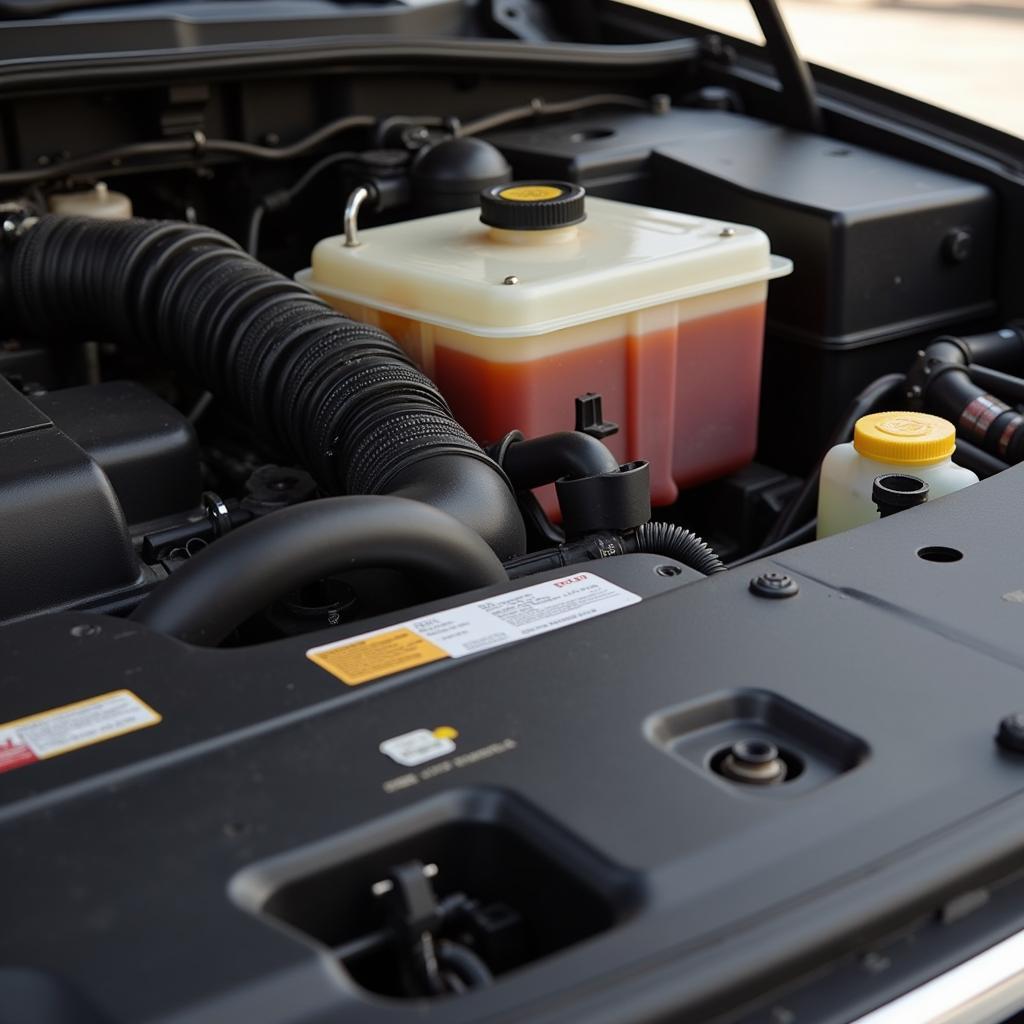Imagine this: you’re driving along, and suddenly, the brake warning light on your dashboard illuminates. It’s a nerve-wracking experience, and for a good reason. This little light is your car’s way of saying, “Hey, something’s not right with the brakes!” Ignoring it could put you and others at risk. But don’t panic. This article will guide you through understanding why your brake warning light is on and what to do about it.
Why is My Brake Warning Light On?
Several reasons could cause your brake warning light to turn on, ranging from a simple oversight to a serious mechanical issue. Let’s break them down:
- Parking Brake Engaged: This is the most common and easiest fix. Always double-check to ensure your parking brake is fully released before driving.
- Low Brake Fluid: Brake fluid is the lifeblood of your car’s braking system. If the fluid level is low, it could indicate a leak, which needs immediate attention.
- Worn Brake Pads: Brake pads have wear indicators that make a screeching sound when they’re nearing the end of their lifespan. If you ignore this sound, the brake warning light might illuminate.
- Faulty Brake Light Switch: The brake light switch activates your brake lights when you press the pedal. A malfunctioning switch can confuse the car’s system, triggering the warning light.
- ABS Issue: Modern vehicles are equipped with an Anti-lock Braking System (ABS). If there’s a problem with the ABS module or sensors, the warning light might come on.
- Master Cylinder Failure: The master cylinder is a vital component that converts the force from your foot on the brake pedal into hydraulic pressure to stop the car. Failure of this component is serious and requires immediate professional attention.
What to Do When the Brake Warning Light Comes On
1. Don’t Panic: Easier said than done, right? However, keeping calm and assessing the situation is crucial.
2. Check Your Parking Brake: Ensure the parking brake is fully disengaged.
3. Find a Safe Place to Stop: If the light remains on after releasing the parking brake, carefully pull over to a safe location away from traffic.
4. Check Brake Fluid Level: If you’re comfortable doing so, carefully check the brake fluid level in the reservoir. If it’s low, there might be a leak.
5. Call for Assistance: If you notice a leak, the brake pedal feels spongy, or you’re unsure about anything, it’s best to err on the side of caution and call for roadside assistance or a trusted mechanic.
 Mechanic Inspecting a Car's Braking System
Mechanic Inspecting a Car's Braking System
“Driving with a brake warning light on is akin to walking on a tightrope without a safety net,” says John Miller, a seasoned automotive engineer with over 20 years of experience. “It’s simply not worth the risk. Get it checked immediately.”
Can I Still Drive with the Brake Warning Light On?
The short answer is: It’s not recommended. Driving with a brake warning light illuminated is incredibly risky. While it might seem like your brakes are working fine, the underlying issue could worsen, leading to sudden brake failure.
Remote Diagnostics and Software Solutions: The Future of Car Repair
In today’s technologically advanced world, remote diagnostics and software solutions are transforming how we diagnose and fix car problems, including brake issues.
For instance, if your 91 Civic hatchback seat belt warning light is also on, it could be a simple wiring issue affecting both systems. With remote diagnostics, a technician can analyze your car’s computer system remotely and potentially identify the root cause without needing a physical inspection.
Conclusion
The brake warning light is a critical safety feature in your car. Never ignore it. If it illuminates, take immediate action to determine the cause and seek professional help if needed. Remember, your safety and the safety of others on the road are paramount.
FAQs
1. What does a flashing brake warning light mean?
A flashing brake warning light usually indicates a serious issue with the ABS (Anti-lock Braking System) or a significant drop in brake fluid level.
2. Can I add more brake fluid myself?
Yes, you can add brake fluid temporarily, but it’s crucial to use the correct type specified in your car’s manual. However, it’s essential to get your car inspected to find and fix the root cause of the low fluid level.
 Close-up of Brake Fluid Reservoir with Low Fluid Level
Close-up of Brake Fluid Reservoir with Low Fluid Level
3. How much does it cost to fix a brake warning light issue?
The cost can vary significantly depending on the underlying cause. A simple brake pad replacement might cost a few hundred dollars, while a master cylinder replacement could cost significantly more.
4. How often should I get my brakes checked?
It’s a good practice to have your brakes inspected at least once a year or every 12,000 miles, whichever comes first.
5. What is remote diagnostics, and how can it help with brake problems?
Remote diagnostics allows technicians to access your car’s computer system remotely to diagnose issues. This technology can be particularly helpful in identifying electronic faults related to the braking system, such as sensor problems or software glitches.
